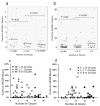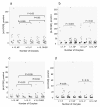Circulating LH/hCG receptor (LHCGR) may identify pre-treatment IVF patients at risk of OHSS and poor implantation
- PMID: 22195987
- PMCID: PMC3285531
- DOI: 10.1186/1477-7827-9-161
Circulating LH/hCG receptor (LHCGR) may identify pre-treatment IVF patients at risk of OHSS and poor implantation
Abstract
Background: Successful pregnancy via in vitro fertilization (IVF) depends on the recovery of an adequate number of healthy oocytes and on blastocyst implantation following uterine transfer. Two hormones, LH and hCG, utilize a common LH/hCG receptor (LHCGR), variations in which have profound implications in human reproduction. Soluble LHCGR (sLHCGR) is released from experimental cell lines and placental explants and it can be detected in the follicular fluid and serum.
Methods: To evaluate the impact of circulating soluble LHCGR (sLHCGR) in fertility treatment, we measured sLHCGR and LH-sLHCGR complex in serum from women seeking IVF using specifically developed quantitative enzyme-linked immunosorbent assays (ELISA). Following an IVF cycle of treatment, patients were grouped according to oocyte yield into low (lower than or equal to 7 oocytes), intermediate (8-14 oocytes) and high (greater than or equal to 15 oocytes) responders and pregnancy outcome noted.
Results: Pre-treatment sLHCGR identified many women at risk of ovarian hyperstimulation. Low levels of sLHCGR were associated with pregnancy in both high and low responders but sLHCGR did not significantly affect the treatment outcome of intermediate responders. Low responders who failed to become pregnant had high levels of circulating sLHCGR bound to LH (LH-sLHCGR).
Conclusions: Pre-treatment measurement of sLHCGR could be used to tailor individual fertility treatment programs and improve outcomes by avoiding ovarian hyperstimulation and poor embryo implantation.
Figures






References
-
- Edwards RG. Widening perspectives of intracytoplasmic sperm injection. Nat Med. 1999. - PubMed
-
- Daya S. Luteal support: progestogens for pregnancy protection. Maturitas. 2009;1(65 Suppl):S29–S34. - PubMed
-
- Lainas T, Zorzovilis J, Petsas G, Stavropoulou G, Cazlaris H, Daskalaki V, Lainas G, Alexopoulou E. In a flexible antagonist protocol, earlier, criteria-based initiation of GnRH antagonist is associated with increased pregnancy rates in IVF. Hum Reprod. 2005;20(9):2426–2433. doi: 10.1093/humrep/dei106. - DOI - PubMed
-
- Nelson SM, Yates RW, Lyall H, Jamieson M, Traynor I, Gaudoin M, Mitchell P, Ambrose P, Fleming R. Anti-Müllerian hormone-based approach to controlled ovarian stimulation for assisted conception. Hum Reprod. 2009;24(4):867–875. - PubMed
Publication types
MeSH terms
Substances
LinkOut - more resources
Full Text Sources

